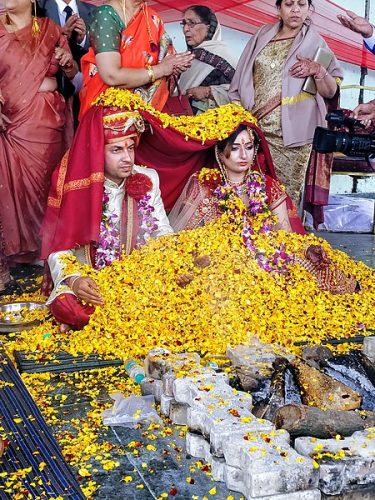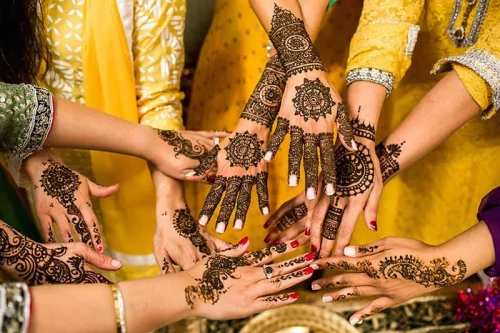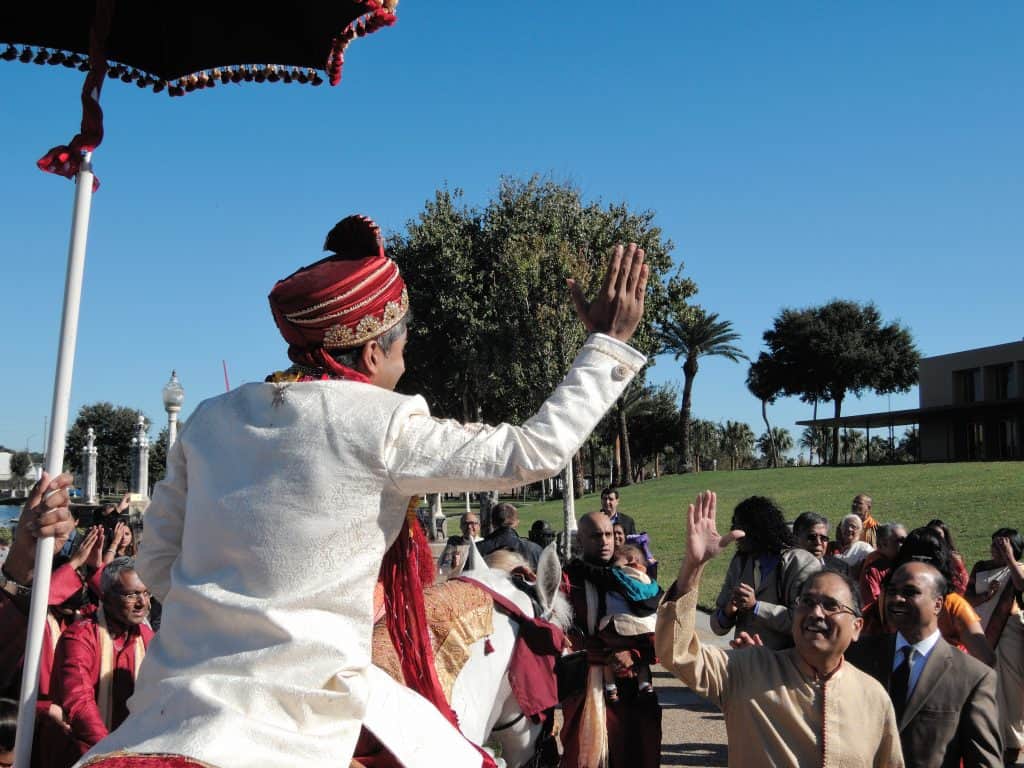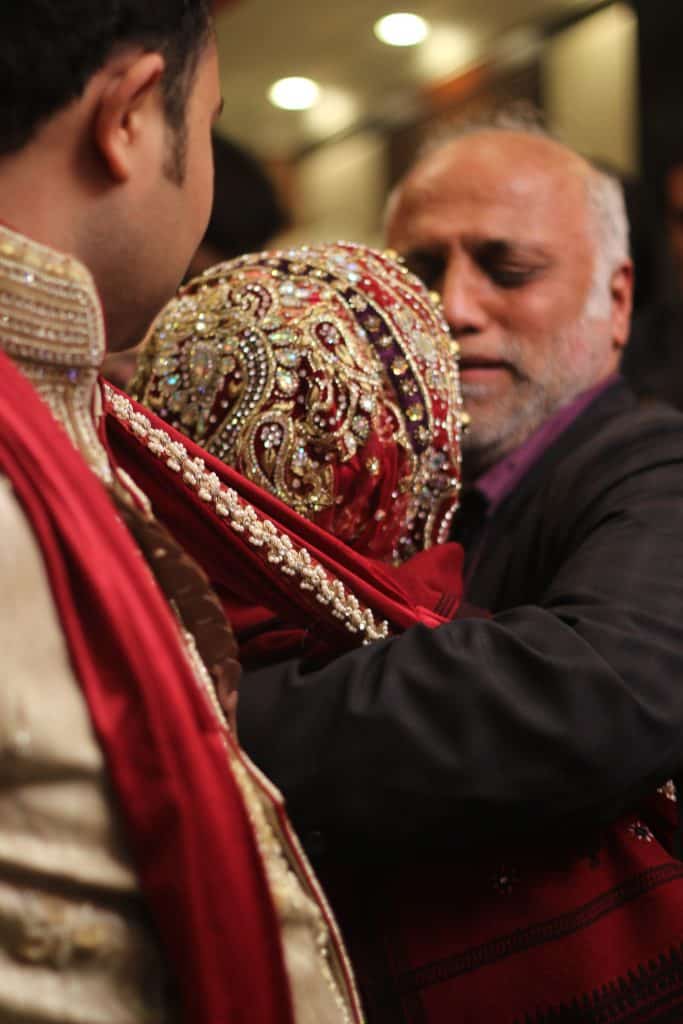Discover the enchanting rituals and vibrant traditions that make Kashmiri Hindu weddings a mesmerizing blend of culture, love, and celebration.

Steeped in the exceptional beauty of Kashmir, the Kashmiri wedding ceremony is a mesmerizing blend of traditions, creating a truly enchanting experience. From delightful vegetarian cuisine and unique family customs to the traditional attire of the bride and groom, a Kashmiri Hindu wedding is a cherished memory waiting to happen.
Kashmiri Pandit weddings, rich in culture and ethnicity, are like a breathtaking fairytale brought to life. Every element, from pre-wedding ceremonies to the wedding outfits, is a sequence of mesmerizing details.
Arranged marriages among Kashmiri Pandits are blessed by both families, with considerations of family virtues and socio-religious factors. The families match the teknis (horoscopes) of the couple. Once the horoscopes align, the families agree on the wedding. The girl’s family proposes a date, which is then approved by the groom’s family, and the priest seals the date.
With formalities completed, the wedding begins in full fervour.
Our detailed guide will walk you through the cultures and rituals of the wedding, helping you appreciate the rich heritage of the Kashmir valley and providing essential guidance if you’re planning a Kashmiri Pandit wedding.
Pre-Wedding Rituals:
Much like Kashmir’s stunning landscapes, its weddings are a harmonious blend of tradition and beauty. Pre-wedding rituals take place in both the couple’s homes on an auspicious date chosen by their families. While song and dance are integral to the celebration, as with any Indian wedding, the ambience here is serene and elegant, reflecting the unique charm of Kashmiri culture.
This is how it goes……..
Kasamdry
Kasam Drei, meaning “giving your word,” is when the families of the boy and girl agree to the marriage in principle. A crucial requirement is that the Tekinye (horoscopes) of both must match, a nearly sacred tradition. The formal commitment ceremony, known as Kasam Drei, takes place at a temple. Families meet, exchange flowers, and offer puja to honour the match, followed by a traditional vegetarian meal prepared by the girl’s family. The aunts of both the bride and groom prepare a special rich pudding called ‘Var,’ which is then shared with family and friends.
Gandun
Gandun, which means “tying up,” is the formal engagement ceremony held at the respective homes of the bride and groom. The family priest sets the date according to the Kashmiri calendar. This ceremony occurs in front of a worshipped idol. On this day, the groom’s sister or sister-in-law visits the bride’s home with a gold Tyok (tikka) and an adorned golden thread called Narivan (Mauli) for the bride.
She applies the Tyok to the bride’s forehead and ties the Narivan to her wrist. She also brings gifts such as a saree, shawl, silver cup with cream, salt, and sugar for the bride. Additionally, she hands over the groom’s Zaatukh (horoscope scroll), which remains with the bride’s family until the wedding. On her return, she receives gifts, clothes, jewellery for the groom, and blocks of crystallized sugar called Nabad Noet.
Livun
Livun marks the exciting kick-off to the grand wedding festivities, rooted in the age-old tradition from when people lived in mud huts. This ceremony involves a symbolic and thorough cleaning of the bride and groom’s homes, performed by married women from each family, who are often rewarded with money or clothes. During Livun, surfaces like walls and floors are daubed, symbolizing the ceremonial cleaning of the house. In the past, Kashmiris lived in mud houses, and on this day, these homes were cleaned and given a fresh coat of mud or clay to spruce them up.
The ceremony of Livun, is followed by a special ritual called Mas Muczravun, where the Poff (father’s sister) unties and loosens the bride’s hair, which remains open until the wedding day. Women burn Isband (wild rue seeds) in the Kangir (fire pot), touching a pinch of seeds to each other’s shoulders and heads, letting the fragrant fumes ward off evil. They gather to sing traditional Kashmiri folk songs and wedding ballads in a distinct style called Wanvun.
The Poff (father’s sister) prepares a savoury rice porridge called Vaer, shared with friends and family. Since all the wedding food is home-cooked, a Waaza (traditional Kashmiri cook) and his team are hired. On this day, they set up the Wur, a wood-fired multi-top clay oven, in the backyard, where all subsequent feasts are cooked. Livun sets the tone for the joyous celebrations to come, blending tradition with the excitement of the wedding preparations.
Maenziraat
Maenz is the Kashmiri term for Mehndi, and Raath means Night — together, Maenziraat is the night of mehndi, song, and dance that takes place a couple of days before the wedding. This ceremony prominently features the bride’s maternal and paternal aunts. At the bride’s house, a bathing ritual is performed where her feet are washed by her maternal aunt. Afterward, her eldest aunt applies henna (mehndi) on her palms and feet.

The remaining henna is then shared among the other women present. They enjoy a delicious meal prepared by the waza (traditional Kashmiri cook). A small amount of henna is also applied to the groom’s hands for good luck during a smaller function at his home.
Devgoan
This significant ritual, typically held a day before the wedding, symbolizes the transition of the bride and groom from Brahmacharya Ashram to Grahasthya Ashram.
At their respective homes, the bride and groom undergo the Kanyi Shraan — a ceremonial bathing ritual. In this tradition, the Maamanye (maternal aunt) cleans the Vuz (main lobby of the house), and the bride or groom is seated at the centre. Water mixed with milk is poured over them through a muslin cloth held by four young girls (Kanya), one at each end.
After the bath, the bride or groom changes into new clothes gifted by the mother’s side, and any old clothes or accessories are given away. The Poff then styles the bride’s hair by parting it in the centre with Tull’e Moor (mulberry tree twigs) and loosely tying it with a red sacred thread into two sections.
Following this, the bride and groom participate in a Havan, offering prayers to Parvati and Shiva according to Vedic rituals performed by the priest. They observe a fast before the puja. The bride’s gold ornaments and utensils, given by her family, are placed in front of the yagna and sanctified during the ceremony.
A noteworthy mention is the Atth and Dejhor. Kashmiri Pandit women wear a gold chain with an attached pendulum in both ears, identifying them as married Kashmiri Pandits. This ornament holds deep spiritual significance. The Dejhor, a hexagon-shaped gold pendant, represents the union of Shiva and Shakti, while the Atth is the gold chain that holds the Dejhor, worn in both ears.
Wedding Day Rituals:
Baraat
The groom’s family is warmly welcomed by the bride’s family at the wedding venue with the blowing of a conch shell. Both families exchange nutmegs as a symbol of lifelong friendship.

Lagan
Once the Baraat arrives at the bride’s home, the women of her family welcome them with Vanvun. The groom and his family are garlanded with marigold flowers, and a conch is blown to ward off any evil spirits. Unlike other Indian weddings, Pandit weddings do not feature a music band or dancing.
As the groom steps into the courtyard, both he and the bride stand on the Vyoog, a traditional rangoli. The eldest lady of the bride’s family performs a traditional Aalath (similar to an Aarti) and offers Nabad sugar crystals. This is followed by Dwar Poozah at the main entrance, a small puja conducted by the priest. The bride wears Pulhor (straw sandals) for this ceremony.
The bride, groom, grandparents, and all from their gotra fast until the Laegan is completed. The nuptial knot is tied through a long puja, following Vedic rituals at the Mandap with a lit yagna. The extensive puja rituals span several hours, culminating in the Kanyadaan, where the bride’s father or eldest family member gives her hand to the groom.
The couple sees each other for the first time during the ceremony in the reflection of a mirror shown by the priest. Throughout the ceremony, the groom and bride hold hands covered with a special cloth, known as Athwas. A golden thread with embellishments, Mananmal, is tied to their foreheads.
The bride and groom take Pheras (rounds) around the sacred fire, holding hands. They also undertake the Saptapadi, where the groom makes seven promises to the bride. With each step the bride takes towards her new home, the priest announces a condition for the groom to accept. The marriage is solemnized only when these seven promises are made.
Poshe Poozah
At the conclusion of the wedding ceremony, the bride and groom sit down together. A red cloth is placed over their heads, and the surrounding guests shower them with flowers (posh) while Vedic mantras are chanted. This act symbolizes the worship of the couple Shiva and Parvati, blessing them with love and prosperity.
Vidayi
This is the moment when the bride formally bids farewell to her family. During this ceremony, the couple stands on a wooden pedestal called Vyoog. The eldest female family member kisses them thrice on the forehead in a gesture known as offering Nabad.

Post-Wedding Rituals
SATRAATH
Upon arriving at her new home, the bride is warmly welcomed by her husband’s friends and family. Later that evening, the couple visits the bride’s family for dinner. The bride changes into another saree, this one gifted by her mother, and returns to her new home with gifts and blessings.
Phirlath
A few days after the wedding, the couple visits the bride’s parents for the second time. During this visit, they enjoy a feast and receive gifts to commemorate the occasion.
Roth Khabar
On a Tuesday or Saturday, the bride’s parents send a traditional freshly-baked cake called Roth to their daughter’s home. Following this, the bride returns to her maternal house for a few days with the person who delivered the cake.
Ghar Atchum
Ghar Atchum is a formal reception ceremony hosted by the bride’s family. After this event, the bride returns to her husband’s home.
From the joyous Wanvun to the sacred Lagan and the poignant Vidayi, every moment is a testament to the rich heritage and enduring traditions of Kashmir. Kashmiri weddings are a mesmerizing blend of rituals, music, and heartfelt moments that celebrate the union of two souls and the merging of two families.
Each ritual, steeped in cultural significance, adds a unique flavour to the festivities, creating memories that last a lifetime. Whether you’re attending or planning a Kashmiri wedding, these rituals offer a beautiful journey through love, culture, and celebration.
Livun Ceremony – Food Traditions
The Livun ceremony, an essential part of weddings, is marked by inviting women from among relatives and neighbours for a special dinner. Traditionally, this meal is served in kiln-baked pots known as tabche, although modern weddings often forgo these pots in favour of more contemporary serving methods.
The culinary delights prepared by the waza, a skilled traditional cook, are a highlight of the ceremony. The menu features an array of traditional Kashmiri dishes. Dumaalu, a popular dish, consists of potatoes cooked in a rich blend of spices, offering a flavorful start to the meal. Nadrooyakhni showcases lotus roots chopped into pieces and cooked in a creamy mixture of milk and curd, creating a unique and savoury taste.
Czhock Wangun provides a scrumptious bitter-sweet experience with brinjal cooked in a medley of spices. Vyath Chaman presents large portions of paneer (cottage cheese) cooked with a robust spice mix, while Nich Chaman offers a milder option with smaller pieces of paneer cooked in turmeric and curd, imparting a gentle yellow hue.
Another staple is Nadroo Hakh, which combines diagonally cut lotus roots with Kashmiri saag (collard greens), resulting in a nutritious and flavorful dish. Finally, Mujchatni brings a refreshing contrast with grated white radish mixed with green chillies and curd, adding a tangy and cooling element to the meal.
These dishes, deeply rooted in Kashmiri culinary tradition, not only provide a feast for the senses but also reinforce the cultural heritage celebrated during the Livun ceremony.
Kashmiri Hindu weddings – a testament to rich cultural heritage
Kashmiri Hindu weddings stand as a testament to the region’s rich cultural heritage and deep-rooted traditions. These ceremonies are a vibrant tapestry woven with rituals, symbolism, and community involvement, reflecting the unique identity of Kashmiri Pandits.
From the meticulous preparation of Wazwan feasts to the sacred Varmala exchange and the solemn Pheras around the holy fire, each element of the wedding holds profound significance. The integration of music, dance, and traditional attire further adds to the celebratory ambience, creating a memorable experience for all involved.
Despite the modern influences, Kashmiri Hindu weddings continue to preserve their distinctiveness, showcasing the resilience and pride of the community in maintaining their cultural legacy. These weddings not only mark the union of two individuals but also reinforce the communal bonds and the timeless traditions that define the Kashmiri Pandit identity. As we witness these captivating ceremonies, we are reminded of the beauty and richness of India’s diverse cultural landscape.
Read more: Latest



